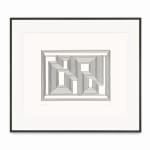Josef Albers
Josef Albers’s Prefatio, completed in 1942, a lithograph from his seminal Graphic Tectonics series, stands as a pivotal exploration of geometric abstraction during a transformative period in his career at Black Mountain College. Created in a moment of transatlantic recalibration, the work marks a critical shift from Albers’s Bauhaus roots toward a distinctly American synthesis of modernist inquiry. Rendered in a stark monochromatic palette, Prefatio distills Albers’s intense scrutiny of visual structure, spatial ambiguity, and perceptual tension. The lithograph’s precise, linear geometry animates a play of advance and recession—figures that simultaneously assert themselves and dissolve—offering a rigorously controlled yet optically unstable field. It is a masterclass in how form, devoid of ornament, can evoke both movement and stillness within the same frame.
At the heart of Prefatio is Albers’s enduring preoccupation with the architecture of seeing. The interlocking planes and directional shifts engage the viewer not only intellectually, but physiologically. Vision becomes an active process, conditioned by the geometry it confronts. In this sense, Prefatio is not a composition in the traditional sense, but an optical proposition—a visual argument for how the mind interprets line, depth, and balance in abstract space. The economy of means—limited palette, uniform tone, absence of figuration—heightens the intensity of the visual experience. This lithograph, like others in the Graphic Tectonics series, anticipates the systemic logic and perceptual experiments that would later define Albers’s contributions to Op Art and Minimalism.
Equally important is the cultural and architectural influence that shaped Albers’s sensibility in these years, particularly his repeated travels to Mexico during the 1930s. The stepped symmetry of Mesoamerican pyramids, the visual weight of colonial façades, and the austere monumentality of pre-Columbian design all left a deep imprint on Albers’s visual imagination. He once remarked that Mexico was “truly the promised land of abstract art,” and it is no exaggeration to suggest that Prefatio bears out that declaration. The lithograph’s architectural clarity—its rhythm of recession, elevation, and alignment—echoes the visual logic of structures like the Pyramid of the Sun at Teotihuacan or the façades of Oaxaca’s convents, translated here into a two-dimensional language of modernist abstraction.
Within the larger trajectory of American postwar art, Prefatio occupies a crucial and often underappreciated position. It represents a moment of synthesis: the convergence of Bauhaus pedagogy with the emerging ethos of American formalism. At Black Mountain College, Albers did not simply transmit European modernism; he transformed it. Through works such as Prefatio, he helped catalyze a uniquely American abstraction—stripped of illusion, rooted in perception, and open to systematic exploration. The visual grammar of this lithograph would go on to influence not only his students—among them Robert Rauschenberg and Ruth Asawa—but also broader movements that prioritized clarity, repetition, and experiential looking.
The enduring significance of Prefatio is affirmed by its presence in numerous major institutional collections, including the Museum of Modern Art and the Metropolitan Museum of Art in New York, the National Gallery of Art in Washington, D.C., the Harvard Art Museums, the Yale University Art Gallery, and the Josef and Anni Albers Foundation. It is also held in European institutions such as MACBA in Barcelona, attesting to the international resonance of Albers’s graphic work. These placements underscore the lithograph’s status not merely as a historical artifact, but as a foundational contribution to the evolving discourse on abstraction, perception, and the intellectual possibilities of printmaking.
NOTES
Image: 11 5/8 x 15 3/4 in (29.5 x 40 cm)
Sheet: 19 x 24 in (48.2 x 61 cm)
This artwork is titled, numbered, signed, and dated in pencil, from the edition of 30.
Provenance
Private collection, United StatesPrivate collection, New York
Literature
Brenda Danilowitz. The prints of Josef Albers: A Catalogue Raisonné, 1915-1976. New York: Hudson Hills Press in association with the Josef and Anni Albers Foundation, 2001, cat. no. 103 (another example illustrated).Brenda Danilowitz and Jeannette Redensek. Josef Albers: Discovery and Invention, The Early Graphic Works. London: Art/Books, Cristea Roberts Gallery, 2021, p. 116 (another example illustrated).




